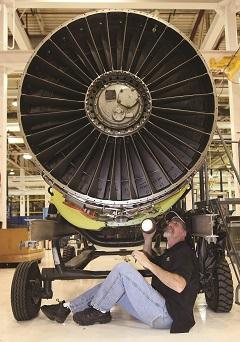

Oklahoma is home to an aerospace industry cluster that is a true cluster and market leader. It is an industry ecosystem that continues to grow, diversify and bring foreign investment to the state.
Oklahoma’s aerospace industry has been a powerhouse for decades. One of only seven global aerospace hubs, Oklahoma is home to the largest military and commercial aircraft maintenance, repair and overhaul (MRO) operations in the United States. Oklahoma is rapidly becoming the “Fly to State” for a wide range of emerging aerospace categories and its aerospace assets continue to grow and diversify.
 An estimated 6.3 percent of the entire state’s economy is attributed to aerospace and defense-related industry. The sector employs more than 150,000 workers and over 500 aerospace-related companies do business in the state. Oklahoma’s aerospace industry has an industrial output that exceeds $12 billion and exports to 170 countries.
An estimated 6.3 percent of the entire state’s economy is attributed to aerospace and defense-related industry. The sector employs more than 150,000 workers and over 500 aerospace-related companies do business in the state. Oklahoma’s aerospace industry has an industrial output that exceeds $12 billion and exports to 170 countries.
Oklahoma aerospace industry cluster is underpinned by a comprehensive training infrastructure, world-class workforce and a wide-range of diverse facilities that support innovation in the industry.
Some of Oklahoma’s related industry assets include the following:
-
The FAA Mike Monroney Aeronautical Center is located in Oklahoma City and is the central training and support facility in the U.S. for the FAA and the U.S. Department of Transportation. The center employs 5,500 and trains more than 20,000 students each year.
-
The Oklahoma City Air Logistics Center at Tinker Air Force Base is the largest depot in the U.S. Department of Defense.
-
Comprehensive UAS (unmanned aircraft/aerial system) infrastructure, which includes the world’s first university graduate degree in UAS and dedicated hangar, runways, urban testing facilities and military airspace available for UAS testing.
-
12 colleges and universities with aerospace programs and six technical centers with dedicated training for the aerospace industry.
-
“Training for Industry Program” (TIP) that provides customized employee training for no or low cost to companies.
-
Fully integrated supply chain made up of over 500 companies that meet the needs of the aerospace industry.
-
Available facilities and sites, including nearly five million square feet of aviation-suited commercial space within a four-mile radius of two international airports and Tinker Air Force Base and nearly 1,500 acres of greenfield space for aviation use near airports.
Three of the main areas where Oklahoma is excelling in the sector are:
-
MRO
-
Parts and components manufacturing
-
UAS.
In addition to being a globally recognized aerospace hub, Oklahoma is home to the largest military and commercial aircraft MRO operations in the United States. Oklahoma City’s Tinker Air Force Base is the largest MRO facility in the U.S. Department of Defense portfolio and the American Airlines maintenance center in Tulsa is the largest commercial MRO in the world.
Tinker Air Force Base alone has an economic impact of $2.79 billion annually and the American Airlines facility in Tulsa has an operating budget of $900 million per year.
Over 500 aerospace companies comprise the component supply chain in Oklahoma. Contributing over $12 billion to the state’s economy, Oklahoma’s parts and component industry exports to more than 170 countries around the world and serves the existing industry base in the state.
One area where innovation is in full swing is in UASs and Oklahoma is a world leader in this segment of the aerospace industry. Oklahoma is globally recognized as being in the forefront of research, development, testing, evaluation, training and education in unmanned aircraft/aerial systems.
Oklahoma’s UAS ecosystem has one of the most comprehensive industry infrastructures in the world. The State is well positioned to provide “one stop shop” solutions in all categories of unmanned aircraft.
Economic forecasts for the growth of the UAS industry globally are expected to rapidly increase. The current world market for UAS technology is estimated to be $5.9 billion and is expected to increase to $15.1 billion over the next decade.
With its central location, ideal terrain, research and development capabilities, testing facilities, training programs, business incentives, comprehensive UAS infrastructure and the only graduate degree in unmanned aerial systems in the world, Oklahoma is leading the industry on all fronts.
The state has the first master’s and doctoral degrees with options in UAV in the U.S. at Oklahoma State University, Stillwater and the State was selected as the test site for the new Department of Homeland Security Robotic Aircraft for Public Safety Program (RAPS). Other unique UAS assets include the University Multispectral Laboratories. Oklahoma State University (OSU) established the University Multispectral Laboratories (UML) as a government-owned, contractor-operated nonprofit corporation, tasked as a “Trusted Agent” to develop and operate a Research, Development, Test, Evaluation and Training laboratory.

Oklahoma also has the only access to restricted airspace for commercial UAV testing in the U.S. and the state is developing homegrown talent and know-how; students at Oklahoma State have dominated the international design/build/fly competition in recent years. To top it off, the cluster is supported by state tax incentives targeting aerospace professionals and companies.
From the lessons learned at the Oklahoma State University Multispectral lab, undergraduate and graduate work, the partnerships with the private sector, the military and the many entrepreneurs operating in Oklahoma, a vibrant industry is emerging for non-military unmanned systems.
Some of the practical applications of unmanned aerial systems technologies include data gathering and inspections for infrastructure such as large bridges and the exteriors of large buildings. The UAVs can access locations humans cannot to provide integral data on structural issues and potential hazards. The technology is virtually limitless and will be driven by specific needs in the marketplace, limited only by imagination.
Oklahoma is at the epicenter of innovation in UAS technology and applications. Fueled by an increasing portfolio of applications for the technology, the industry is booming. Some of the emerging applications include:
-
Biomimicry – embedding biologically inspired remote systems in nature to observe animal behavior and migration patterns
-
General Security/ Public Safety
-
Radar Research – testing the limits of radar in detection
-
Climatologically – weather and atmospheric sciences
-
Surveillance – for policing for local law enforcement and border control agencies
-
Communication – to extend communication range and bandwidth
-
Aeronautics – to optimize and innovate flight dynamics and design
-
Materials – testing of new materials and composites
-
Propulsion – testing of new propulsion design and technologies
-
Power – battery and power source technologies
-
Acoustics – noise control, transmission and acoustic technology
-
Oil & Gas – scanning of pipelines for damage and leaks as well as exploration
-
Sensors – carrying sensor technology for monitoring and testing weather events, water management, data gathering
-
Crop Management – testing and monitoring and crop dusting/maintenance
-
Forestry – monitoring wildfires and potential hazards
-
Traffic – monitoring and optimization of roadways and traffic patterns
-
Cyber Security

